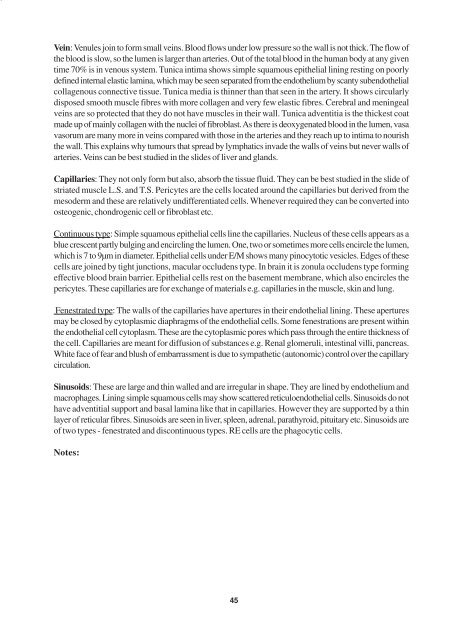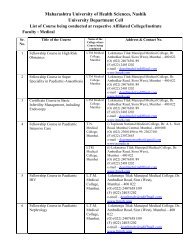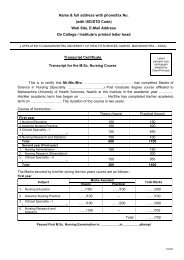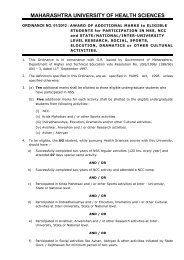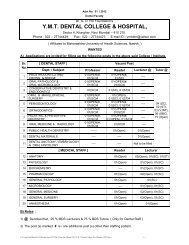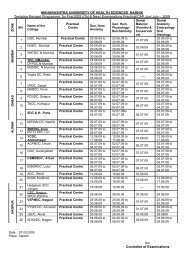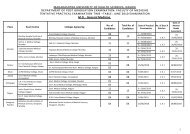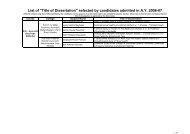Unit I
Unit I
Unit I
You also want an ePaper? Increase the reach of your titles
YUMPU automatically turns print PDFs into web optimized ePapers that Google loves.
Vein: Venules join to form small veins. Blood flows under low pressure so the wall is not thick. The flow ofthe blood is slow, so the lumen is larger than arteries. Out of the total blood in the human body at any giventime 70% is in venous system. Tunica intima shows simple squamous epithelial lining resting on poorlydefined internal elastic lamina, which may be seen separated from the endothelium by scanty subendothelialcollagenous connective tissue. Tunica media is thinner than that seen in the artery. It shows circularlydisposed smooth muscle fibres with more collagen and very few elastic fibres. Cerebral and meningealveins are so protected that they do not have muscles in their wall. Tunica adventitia is the thickest coatmade up of mainly collagen with the nuclei of fibroblast. As there is deoxygenated blood in the lumen, vasavasorum are many more in veins compared with those in the arteries and they reach up to intima to nourishthe wall. This explains why tumours that spread by lymphatics invade the walls of veins but never walls ofarteries. Veins can be best studied in the slides of liver and glands.Capillaries: They not only form but also, absorb the tissue fluid. They can be best studied in the slide ofstriated muscle L.S. and T.S. Pericytes are the cells located around the capillaries but derived from themesoderm and these are relatively undifferentiated cells. Whenever required they can be converted intoosteogenic, chondrogenic cell or fibroblast etc.Continuous type: Simple squamous epithelial cells line the capillaries. Nucleus of these cells appears as ablue crescent partly bulging and encircling the lumen. One, two or sometimes more cells encircle the lumen,which is 7 to 9µm in diameter. Epithelial cells under E/M shows many pinocytotic vesicles. Edges of thesecells are joined by tight junctions, macular occludens type. In brain it is zonula occludens type formingeffective blood brain barrier. Epithelial cells rest on the basement membrane, which also encircles thepericytes. These capillaries are for exchange of materials e.g. capillaries in the muscle, skin and lung.Fenestrated type: The walls of the capillaries have apertures in their endothelial lining. These aperturesmay be closed by cytoplasmic diaphragms of the endothelial cells. Some fenestrations are present withinthe endothelial cell cytoplasm. These are the cytoplasmic pores which pass through the entire thickness ofthe cell. Capillaries are meant for diffusion of substances e.g. Renal glomeruli, intestinal villi, pancreas.White face of fear and blush of embarrassment is due to sympathetic (autonomic) control over the capillarycirculation.Sinusoids: These are large and thin walled and are irregular in shape. They are lined by endothelium andmacrophages. Lining simple squamous cells may show scattered reticuloendothelial cells. Sinusoids do nothave adventitial support and basal lamina like that in capillaries. However they are supported by a thinlayer of reticular fibres. Sinusoids are seen in liver, spleen, adrenal, parathyroid, pituitary etc. Sinusoids areof two types - fenestrated and discontinuous types. RE cells are the phagocytic cells.Notes:45


